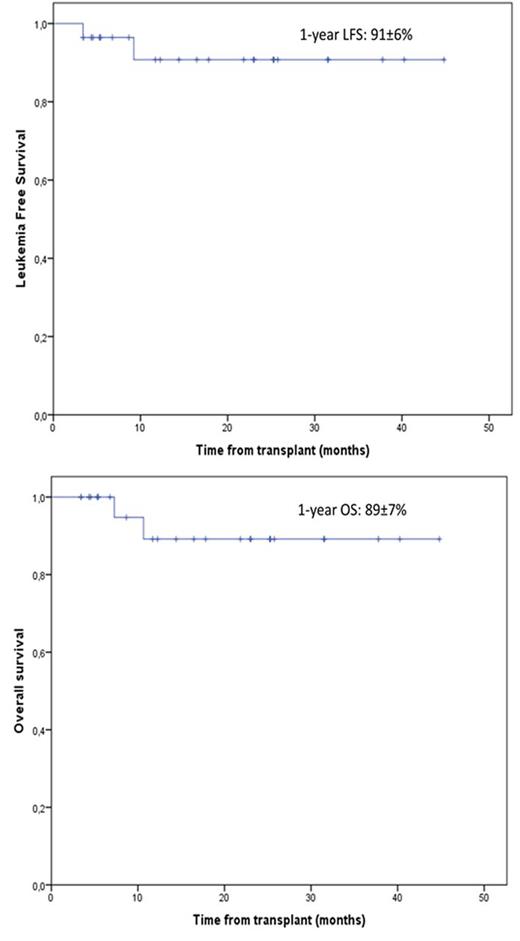Abstract
Introduction: Despite allogeneic hematopoietic stem cell transplantation (HSCT), prognosis of fms-like tyrosine kinase 3 (FLT3) mutated acute myeloid leukemia (AML) remains poor due to the high risk of relapse. Sorafenib, a multikinase inhibitor active on FLT3, has shown encouraging results in these patients.
Patients and methods: Here, we report the use of sorafenib as a maintenance agent after HSCT in 28 adults with FLT3 positive AML treated in three hematologic departments.
Results: A total of 18 males and 10 females were included. All but one patient (pt) underwent their first HSCT between 2012-2016. Median age at HSCT was 45 years (range 16-57). A normal karyotype was detected in all but 5 pts. Ten pts showed FLT3-ITD as sole molecular abnormality, thirteen with concomitant NPM-1 mutation, associated to WT1 overexpression in 1 case and to CEBP-α double mutated in two. Association of FLT3 and WT1 overexpression was observed in 3 pts. Two more pts presented a FLT3-TKD with concomitant NPM-1 mutation.
At time of HSCT, all but 1 pt were in complete remission (CR; CR1, n=23; CR2=3; CR3=1). Thirteen pts in CR had a detectable minimal residual disease (MRD) before HSCT. Median interval from CR to HSCT was 74 days (d, range 6-220). The majority of the pts (n=26) received peripheral blood as stem cell source, 19 from a matched sibling, 4 from a matched unrelated, 3 from a haploidentical donor. A bone marrow unit was used in 2 pts, one matched sibling and one haploidentical donor. Conditioning regimen was myeloablative in 21 pts, while reduced intensity regimen was used in 5 pts, and 2 receiving a sequential regimen. All pts achieved neutrophil engraftment in a median of 16 d.
Median time to sorafenib introduction as a maintenance agent after HSCT was 70 d (range 17-645). Seven pts were out of immunosuppressive treatment (IST) without graft-versus host disease (GVHD) at time of sorafenib start. Sorafenib was started at a dose of 400 mg twice a d (n=13), 200 mg twice a d (n=14) or 200 mg once a d (n=1).
Sorafenib was used as primary prophylaxis in 25 pts, or as secondary prophylaxis in three relapsed pts who received it first in combination with salvage chemotherapy and then, after obtaining subsequent CR, as a maintenance treatment.
Median duration of treatment was 179 d (range 4-1219).
Dose reduction or withdrawal due to toxicities was needed in 5 and 3 pts, respectively. These included gastrointestinal (GI, n=3), cardiac (n=1), skin (n=3, 1 with GI), biochemical (n=1) and hematological toxicities (n=2, 1 with GI). Despite dose reduction, persistence of toxicities prompted to treatment withdrawal in 1 pt.
Disease relapse occurred in 2 pts: in both sorafenib was withdrawn and then resumed after salvage chemotherapy. One pt died for disease progression, the other from non-relapse mortality.
Twelve pts experienced GVHD (limited, n=6; extensive, n=6), resulting in dose reduction in 5 pts, followed by withdrawal in 1 pt. Nine pts required systemic IST. Dose reduction was made in 1 pt due to financial reasons. Three pts received donor lymphocyte infusion (DLI), without experiencing GVHD. Leukemia-free (LFS) and overall survival at one year were 91±6% and 89±7%, respectively. Probability of LFS with undetectable MRD at one year was 87±7%.
With a median follow-up of 15 months (range 4-44), all but 2 pts are alive, all in CR. Sorafenib treatment is ongoing in 18 pts (with 7 at reduced doses) with a median of 15 months (range 1-41).
Conclusion: Our findings suggest that a post-transplant prophylactic strategy is safe and may markedly improve the poor outcome of FLT3 positive AML. A large prospective randomized clinical trial is warranted in order to confirm our results and to determine the optimal treatment modalities. Although the optimal starting dose still remains unclear, dose individualization according to patient tolerability might be considered. Further analysis is needed to evaluate the immunomodulating role of sorafenib post HSCT.
No relevant conflicts of interest to declare.
Author notes
Asterisk with author names denotes non-ASH members.


This feature is available to Subscribers Only
Sign In or Create an Account Close Modal